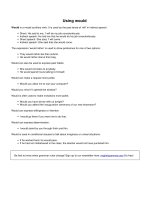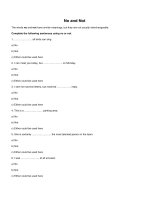Cách sử dụng động từ
Bạn đang xem bản rút gọn của tài liệu. Xem và tải ngay bản đầy đủ của tài liệu tại đây (13.57 KB, 1 trang )
What are verbs?
Read the following sentences:
Mother
cooks
dinner.
Children
play
in the park.
Barking dogs seldom
bite
.
In the sentences given above, the words in bold text are used to say something about a person or a thing. They
say what a person or a thing
does
. These words are called
verbs
. Now read the following sentences.
We
have
two hands and two legs.
She
is
a good girl.
Here the verbs
have and is
show what a person has or is. These words are also called verbs. Thus we have
seen that a verb is a word which shows what a person or a thing is, has or does. The verb may also express what
happens or is done to the person or thing.
The thief
was beaten
. (Here the verb was beaten shows what happens to the thief.)
A verb may consist of more than one word. Some verbs may consist of as many as four words.
It
is raining.
It
has been raining.
It
rains.
Transitive and intransitive verbs
Verbs that take an object are called
transitive verbs.
She heard a noise. (subject – she, verb – heard, object – a noise)
He saw a pigeon. (Subject – he, verb – saw, object – a pigeon)
The girl plucked the flower. (Subject – the girl, verb – plucked, object – the flower)
The master beat the dog. (subject – the master, verb – beat, object – the dog)
Some verbs do not take an object after them. These are called
intransitive verbs
. Examples are: smile, sit,
sleep, cry, laugh, dance etc.
The baby
smiled
. (Here the verb smiled is intransitive because it has no object.)
The child
cried
. (Here the verb cried is intransitive because it has no object.)
He
sat
on the bed. (Here the verb sat is intransitive because it has no object.)
Note that most verbs can be used both transitively and intransitively.
Be first to know when grammar rules change! Sign up to our newsletter here: englishgrammar.org (It's free)
Powered by TCPDF (www.tcpdf.org)









